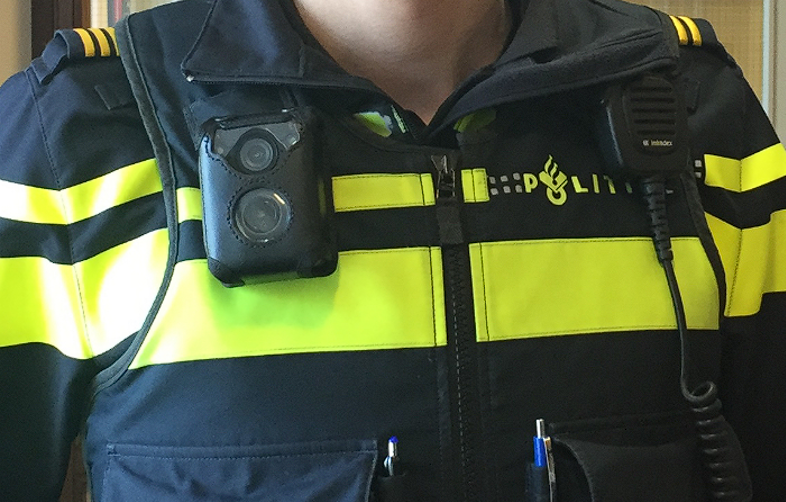
A police officer in uniform wearing a walkie-talkie and a square body-camera by Sanderflight. Image from Wikipedia Commons is licensed under Creative Commons Attribution-ShareAlike 4.0 International.
The public is no stranger to “body-cams”. Images and videos from police body cameras are now a frequent feature in the media as a direct source of “what really happened” during contentious interactions between police and the public. But what have we learned from sociological research about body-cams? Who are they “for”?
Body-Cams
Law enforcement agencies have used recording technologies like dash-cams for years, but the rise of cell phone recordings and public demands for police accountability dramatically expanded the use of body-cams across the US. Body-cams, or cameras attached to the officer’s uniform, vary in the quality of video produced, the requirements regarding when to turn on the camera, and how the recordings are handled and by whom.
- Cynthia Lum, Megan Stoltz, Christopher Koper, & Amber Scherer. 2015. “Existing and ongoing body worn camera research: Knowledge gaps and opportunities.” Center for Evidence-Based Crime Policy, George Mason University.
Research on Body-Cams
Police departments began implementing body-cams in the early 2010s. By 2015, survey showed that 19% of police departments were using body-cams in the United States. One year later in 2016, a different survey reported 47% of police departments were using body-cams – suggesting exponential growth in the use of body-cams during the mid 2010’s. As of 2023, the use of body-cams is likely higher, and many states have since ratified statewide body-cam requirements to different extents for their law enforcement.
Research has shown that officers’ perceptions of body-cams have been largely positive since they can aid and assist with arrests and investigations, and can help address excessive use of force complaints (allegations when a police officer uses more physical force than needed).
- Shelly Hyland. 2018. “Body-worn cameras in law enforcement agencies, 2016. U.S. Department of Justice.” Bureau of Justice Statistics.
- Chiefs, Major Cities. 2015. “Major cities chiefs and major county sheriffs survey of technology needs—body-worn cameras.”
Arrests
Research on arrests and the use of body-cams shows promise. Studies have found that when body-cams are used, officers made fewer arrests, but made more citations (less serious charges than arrests). Researchers suggest that the reason for fewer arrests may be the result of both officers and citizens adjusting their behavior because they are on camera and being recorded. This decreased rate of arrest decreases the burden on police and the criminal legal justice system and can reduce harm to the broader community.
- Barak Ariel. 2016. “Police body cameras in large police departments.” The Journal of Criminal Law and Criminology, 106, 729–768.
- Justin Ready & Jacob Young. 2015. “The impact of on-officer video cameras on police–citizen contacts: Findings from a controlled experiment in Mesa, AZ.” Journal of Experimental Criminology, 11, 445–458.
Excessive Use of Force
The results are more mixed regarding excessive use of force: some research shows a decrease in excessive force after the implementation of body-cams and some studies show no difference. These mixed findings may be tied to whether officers have discretion, or choice, to activate their cameras. In studies that found no effect on excessive use of force, officers had high discretion and could choose when (or when not) to activate their body-cams. In short, if officers have the discretion to turn their body-cams on or off, they may be more likely to use excessive force than when they are required to turn on their body-cams during an interaction.
- Janne Gaub, David Choate, Natalie Todak, Charles Katz, & Michael White. 2016. “Officer perceptions of body-worn cameras before and after deployment: A study of three departments.” Police Quarterly, 19(3), 275-302.
- Janne Gaub, Natalie Todak, & Michael White. 2020. “One size doesn’t fit all: The deployment of police body-worn cameras to specialty units.” International Criminal Justice Review 30(2), 136-155.
Complaints
For formal complaints made by community members, officers who used body-cams had fewer reported complaints against them than those who did not use body-cams. Several studies have shown a marked decline in complaints after body cams are implemented, with one reporting a 90% reduction in complaints against police officers. Such complaints seem to decrease even when the body-cam was not turned on but still physically visible on the officer. It appears that “being on camera” is again impacting the behavior of both officers and community members.
- Barak Ariel, William Farrar, & Alex Sutherland. 2015. “The effect of police body-worn cameras on use of force and citizens’ complaints against the police: A randomized controlled trial.” Journal of Quantitative Criminology, 31, 509–535.
- Michael White, Janne Gaub, & Natalie Todak. 2018. “Exploring the potential for body-worn cameras to reduce violence in police–citizen encounters.” Policing: A Journal of Policy and Practice, 12, 66–76.
- Eric Hedberg, Charles Katz, & David Choate. 2016. “Body-worn cameras and citizen interactions with police officers: estimating plausible effects given varying compliance levels.” Justice Quarterly, 34(4), 1–25.
Future of Body-Cams
Across the board, there are fewer and fewer outright opponents of body-cams. Public discussion now centers around the accessibility of unedited recordings, limited officer discretion of when to activate the body-cam, the privacy of bystanders to crimes, and the development of new laws regulating body-cam use. At the societal level, body-cams are generally considered an asset and a means to help both police and community members stay accountable and safe.

Comments